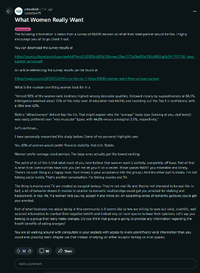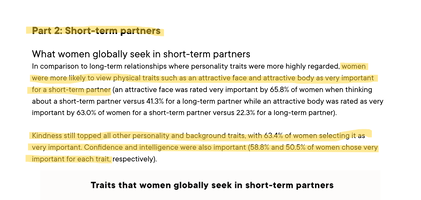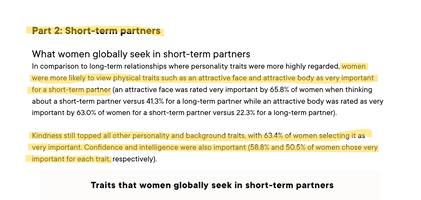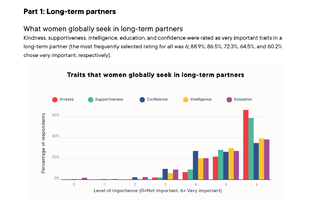IceMan2000
Officer
★★★★★
- Joined
- Aug 8, 2023
- Posts
- 951
View: https://www.reddit.com/r/IncelExit/comments/1f1mxh5/what_women_really_want/
Lets take a look in hereThe following information is taken from a survey of 68,000 women on what their ideal partner would be like. I highly encourage you all to go check it out.
You can download the survey results at
https://assets.ctfassets.net/juauvl...cbf9fb5a2e541/191105_Ideal_partner_survey.pdf
What is the number one thing women look for in a
65,000 women and only 2000 men participated in this survey? Seems pretty skewed but ok. Also, they never mention where they found (in the original pdf) their target
audience to participate in this survey. (Important, will get back to this)
How irresistible! I cant blame themThe most important physical features to women seeking long-term relationships were an attractive smile and attractive eyes.
In terms of how tall an ideal partner should be, 90.7% of women said that they preferred their long-term partner to be taller than them (81.7% said taller than them and 10.0% said much taller than them).
From the original post:
An article referencing the survey results can be found at
https://nypost.com/2019/07/24/this-is-the-no-1-thing-64000-women-want-from-a-lover-survey/
What is the number one thing women look for in a (man)
“Almost 90% of the women rank kindness highest among desirable qualities, followed closely by supportiveness at 86.5%. Intelligence received about 72% of the vote; level of education had 64.5%; and rounding out the Top 5 is confidence, with a little over 60%.
Notice “attractiveness” did not top the list. That might explain why the “average” body type (looking at you, dad bods!) was vastly preferred over “very muscular” types, with 44.8% versus a marginal 2.5%, respectively.”
A tangent: The coined term 'dad bod' means nothing at all. Most men without any intention have "dad bods". If you are way below or above average in being fat or skinny, you do not fall in the category of 'dad bod' (or very obviously hit the gym, swole).
Everyone calls both of these 'dad bods' without questioning the term
THIS, this is what they see the average body type as. A normal white man with a semi-athletic build, in plain, good fitting clothes.
Not the 50 year old, out of shape truck driver physique they're peddling as "dad bod"
Here is where it gets interesting
So that's settled it! We've been proven wrong all along
Now here is where I wished both graphs had the same metrics. Why would they leave out obviously important information for (physical) attraction, choosing to use different metrics?
At this point I decided to do some digging because something was not adding up.
I came upon more details on here: https://osf.io/bnjfh
From their own description of the study and its main purpose:
Research Questions:In the current study, we are interested in how people’s intention to become a parent may be related to the importance ascribed to the different partner preference dimensions. Founding a family is a major life goal for many adults. Becoming a parent constitutes a very meaningful transition in many people‘s lives (Baum & Stewart, 1990) and is typically preceded by individuals forming the intention to become a parent. Importantly, people‘s ideas of what an ideal partner should be like may track these intentions. First of all, the intention to become a parent should be linked to the preference for a partner who wants to become a parent as well.
1. Ideal partner preferences.
1.1. How is the intention to become a parent linked to the preference for a partner’s intention to become a parent?
1.2. How is the intention to become a parent linked to preferences for kindness and supportiveness (~warmth-trustworthiness)?
1.3. How is the intention to become a parent linked to preferences for attractiveness (~vitality-attractiveness)?
1.4. Is the link between intention to become a parent and preferences for attractiveness (~vitality-attractiveness) moderated by gender?
1.5. How is the intention to become a parent linked to preferences for financial security and successfulness (~status-ressources)?
1.6. Is the link between intention to become a parent and preferences for financial security and successfulness (~status-ressources) moderated by gender?
It is established on the registry that they are for the intention to gain insight on those partner's preferences . On the original pdf posted on reddit there aren't any indications that that was the original intent of the study and answers given on the graphs. Mind you that OP never brought it up once, but I think that was a tremendous oversight for the conclusions they're trying to make.The One to Have my Baby: Ideal Partner Preferences and Their Link to the Intention to Become a Parent in Single Individuals
I'm seriously starting to question how valid these numbers really areStudy design:
The study design is a cross-sectional survey. All participants took part in a 10-minutes survey consisting of 14 questions focusing on demographic information and ideal long-term preferences. All questions relevant to this research question were answered in the first part of the survey. In a second step, they could answer an optional 20-minutes survey with 30 questions. This part consisted of questions concerning past relationships, ideal short-term preferences and preferences for physical features.
only 2000 men participated in this survey?
Of the men who did participate, they were guaranteed to be mostly chads who routinely got laid enough to the point they regularly bought custom fucking condomsData collection procedures:
To reach a sizable number of male participants (in addition to the predominantly female Clue user base), Clue partnered with the condom company myOne for the Ideal Partner Survey. The survey was advertised via email campaigns to the respective user bases, push messages within the Clue app, and social media channels, including Twitter, Facebook and Instagram.
So, why does kindness score the highest of them all in this survey?
This is very important to note. Guys, which of these would you pick if you had to raise a child for 18 years? A 9/10 who makes it very obvious, deliberately or not, that they have PLENTY of options available to them, simps, chads, everything in-between. Or a 6/10 who is loyal, helps out, loves spending time with you and is generally nicer to be around.
In effect, these are the two options most women have available to them currently.
This is why I think they opted to use the word 'kind'. And we already know women are extremely selective with looks so them choosing someone 'kind' is essentially them playing their bargaining chip when they realize, "this is it, It can't get any better then this", and choose settling down.
Overall there are far too many discrepancies that reveal themselves when a study/survey is done this way. If people say they preferred other qualities over others on a survey format, that doesn't necessarily mean the absence of those other qualities (base level attraction) would indicate that that is what they explicitly look for in a partner. Moreover in the context of the article and the IncelExit post, they are extrapolating far too much information than there is in this to properly go off of in a coherent manner.
Not to mention that they mostly want everything deemed as good in a "short term partner" anyways, and on top of that, they use different metrics for the LTR graph. This effectively makes whatever they were asking useless if the intent of the questions were solely for finding LTR's and STR's (which is why it was never intended to be perceived the way the article and reddit post made it seem to in the first place
To put into perspective, the study is about as useful as trying to pair people based on their preference of alcoholic drinks and measuring how much they enjoy the beverage, as a way to as a way to positively correlate relationship compatibility with. Obviously those of us on here know how silly that sounds
The study in a way feels as if it is trying to undermine how attraction ultimately plays a role in the deciding factor for partnerships by deliberately excluding better, more definitive terms over general ones.
This unintentionally led me down a rabbit hole of Partner preference related paper/s.
Abstract
"Many psychological hypotheses require testing whether the similarity between two variables predicts important outcomes' or example, the ideal standards model posits that the match between (A) a participant’s ideal partner preferences, and (B)the traits of a current/potential partner, predicts (C) evaluative outcomes (e.g., the decision to date someone, relationship satisfaction, breakup); tests of the predictive validity of ideal-matching require A × B → C analytic strategies. However, recent articles have incorrectly suggested that documenting a positive sample wide correlation between a participant’s ideals and a current partner’s traits (an A-B correlation) implies that participants pursued, selected, or desired partners with traits that matched their ideals. There are at least six alternative explanations for the emergence of a sample wide A-B correlation; A-Bicorrelations do not provide evidence that ideals guide the selection/evaluation of specific partners. We review appropriately rigorous A × B → C tests that can aid scholars in identifying the circumstances in which ideal-matching exhibits predictive validity."
"A correlation between A and B does not provide compelling support for the predictive validity of ideal partner preference-matching, regardless of whether the A-B correlation is calculated between-subjects on a single trait (Conroy-Beam& Buss, 2016; Gerlach et al., in press) or as a profile correlation across all traits (Campbell et al., 2016). If B reflects the traits of the current romantic partner, an A-B correlation addresses the conceptual question of whether people’s preferences are associated with what they have in a partner. If A is assessed before the partner actually becomes a romantic partner, then an A-B correlation addresses the conceptual question of whether people’s preferences are associated with what they will have in a partner. However, matching hypotheses such as the one posed by the ideal standards model posit that the extent of match should predict a consequential outcome—that is, ideal-matching purportedly guides choices and evaluations, such as partner pursuit, selection, desire, satisfaction, or fulfillment of ideals. The three articles highlighted above interpret ideal–trait correlations as providing evidence that bears on conceptual questions about the way in which ideals might guide such processes without assessing or reporting outcomes (C) related to pursuit, selection, desire, satisfaction, or ideal-fulfillment."
"A match between a person’s preferences and what he or she has is inherently ambiguous; indeed, any correlation between an individual difference and what a person has is inherently ambiguous with respect to active selection (e.g., intelligent children have intelligent parents, but they do not select their parents on the basis of intelligence). In the case of partner preferences, ideal–trait correlations can be greater than zero for at least seven plausible reasons (see Table 2)"
Ideal partner preference Mechanism | Mechanism Description | Mechanism example | Possible explanation for A ↔ B effect | Possible explanation for A × B → C effect
| 1. Assortative mating plus self- enhancement | People with popular traits pair up and my own traits affect my ideals. | Attractive people get to date other attractive people due to market forces (i.e., assortative mating). Unrelatedly, attractive people also think attractiveness is an ideal trait because it characterizes them (i.e., self-enhancement). | Yes | No |
| 2. Passive ideal change | The people around me affect my ideals. | Highly educated people are surrounded by other highly educated people. This causes them to (a) value education as an ideal and(b) meet and date highly educated people. | Yes | No |
| 3. Motivated ideal change | My partner affects my ideals. | My partner is ambitious, which motivates me to value ambition in an ideal partner | Yes | No |
| 4. Perceiver effects | My ideals affect the way I see the people around me. | I think warmth is important in an ideal partner and I generally think people (including my partner) are warm. | Yes | No |
| 5. Motivated projection | My ideals affect the way I see my partner. | I think intelligence is important in an ideal partner and so I am motivated to believe my partner is intelligent. | Yes | No |
| 6. Situation evaluation and selection | I select environments filled with people who do (vs. do not)match my ideals. | I ideally want a partner who is humorous, so I join a comedy group rather than a musical group. Thus, I am more likely to meet and date humorous people. | Yes | No |
| 7. Partner evaluation and selection | I positively evaluate and select partners who do (vs. do not)match my ideals. | I ideally want a partner who is adventurous, so I am more likely to positively evaluate and select partners if they are adventurous. | Yes | Yes |
"Importantly, the six alternative explanations do not constitute a garden variety correlation ≠ causation critique. Rather, they describe psychological processes that will produce an A-B correlation in a world where ideal-matching is irrelevant to the active selection of specific partners. In other words, a person’s ideals (A) might be associated with the characteristics of the partner that he has (B) even if the A-B match is not associated with the extent to which he preferentially pursued or desired a particular partner or fulfilled his ideals through active partners selection."
"For decades, scholars addressing this topic have recognized that an A-B correlation (e.g., the correlation between two couple members’ attractiveness levels) does not indicate that couple members chose each other based on their similarity"
"The field cannot achieve greater theoretical and empirical precision if we use statistically and conceptually imprecise approaches in place of more precise and rigorous ones. "
The paper itself has further statistical analysis, but the TL;DR is this: Ideal partner preference hypothesis in itself is a very flawed way of scraping data, because as mentioned before, there are multiple factors at play into why someone decides to get into a relationship that aren't overtly clear from get-go. The paper in this case argues from a psychological standpoint."For this reason, we strongly encourage scholars to exercise skepticism and avoid interpreting A-B correlations as reflecting the active fulfillment of ideals."
This helps put to rest the le"Eastwick, Finkel, and Eagly (2011, Study 3) and inferred from A-B correlations (i.e., without assessing C outcomes) that participants pursue partners who match their ideals—a deeply problematic inference."
View: https://www.youtube.com/watch?v=KQq__D8C5e0
In a crude attempt to takedown the blackpill, they inadvertently steel manned it
Additional Resources:










